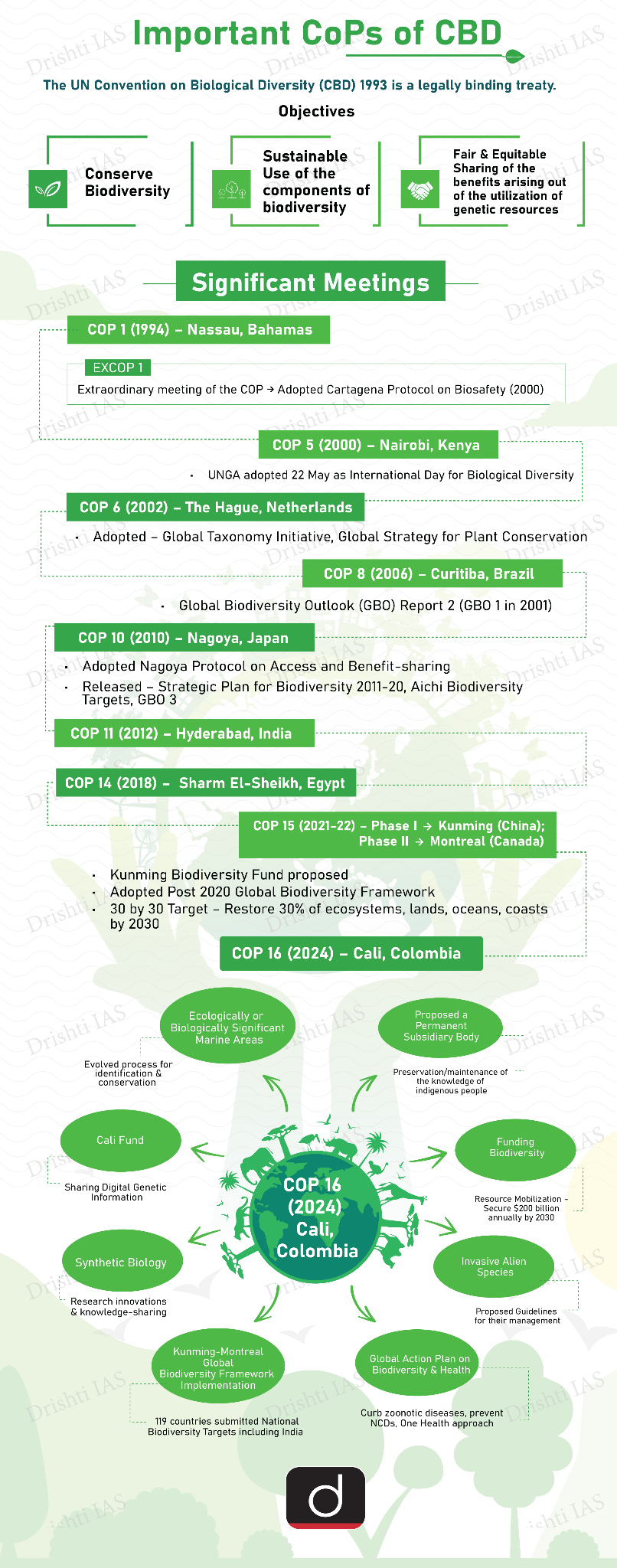Important Facts For Prelims
Biological Diversity (Access and Benefit Sharing) Regulation, 2025
- 05 May 2025
- 7 min read
Why in News?
The National Biodiversity Authority (NBA) notified the Biological Diversity (Access to biological Resources and Knowledge Associated thereto and Fair and Equitable Sharing of Benefits) Regulation 2025 to ensure fair benefit sharing from the use of biological resources.
What are the Key Highlights of the Biological Diversity (Access and Benefit Sharing) Regulation, 2025?
- Benefit Sharing Linked to Turnover: All users who have an annual turnover of over Rs 1 crore need to share a statement with information on the resources used per year.
|
Annual Turnover |
Benefit Sharing Rate |
|
Up to Rs 5 crore |
Exempt |
|
Rs 5 – Rs 50 crore |
0.2% |
|
Rs 50 – Rs 250 crore |
0.4% |
|
Above Rs 250 crore |
0.6% |
- High-Value Biological Resources: For high-value biological resources like red sanders, sandalwood, agarwood, and threatened species under the Biodiversity Act, 2002 benefit sharing must be at least 5% of the sale or auction amount, and can exceed 20% for commercial use.
- Digital Sequence Information (DSI): The 2025 Regulation replaces the 2014 Guidelines, expanding the scope to include DSI, which can now be considered part of genetic resources, unlike the earlier framework.
- DSI refers to the digital representation of genetic sequences derived from Deoxyribonucleic acid (DNA), Ribonucleic acid (RNA), or proteins of organisms. It's essentially the digital code of an organism's genetic makeup.
- Researchers & IP Applicants: The Regulation mandates benefit-sharing for researchers and intellectual property applicants, with 10-15% of the collected benefits retained by the NBA.
- Cultivated Medicinal Plants Exempt: Cultivated medicinal plants are exempt from benefit sharing.
- This exemption stems from the Biological Diversity (Amendment) Act 2023, which promoted medicinal plant cultivation and eased compliance for AYUSH practitioners.
What is Access and Benefit Sharing?
- About: ABS refers to the process of granting access to biological resources (such as plants, animals, or genetic material) and ensuring that the benefits arising from their use whether monetary or non-monetary are equitably shared with the source communities or nations.
- ABS relies on prior informed consent (PIC) from the provider and negotiations to establish mutually agreed terms (MAT) for the fair and equitable sharing of genetic resources and associated benefits.
- Framework: Rooted in the Convention on Biological Diversity (CBD). The Nagoya Protocol, adopted in 2010 under the CBD, provides a legally binding framework for access to genetic resources and fair benefit-sharing.
- COP-16 of the CBD (2024), held in Cali, Colombia, finalized key modalities for a multilateral mechanism to share benefits from the use of DSI.
- In India ABS is implemented through the Biological Diversity Act, 2002) and ABS Regulation, 2025.
National Biodiversity Authority
- The NBA, established in 2003 under the Biological Diversity Act, 2002, is a statutory body that advises the Centre on biodiversity conservation, sustainable use, and fair benefit-sharing.
- Headquartered in Chennai, It operates through a decentralized structure involving State Biodiversity Boards (SBBs) and local Biodiversity Management Committees (BMCs).
- While SBBs guide state governments and regulate commercial use, BMCs focus on local biodiversity documentation and conservation.
- BMCs are responsible for preparing People's Biodiversity Registers (PBRs).
- Since its establishment, NBA has supported creation of SBBs in 28 States, 8 UT's and facilitated establishment of around 2,77,688 BMCs.
UPSC Civil Services Examination Previous Year Question (PYQ)
Q. Consider the following statements: (2023)
- In India, the Biodiversity Management Committees are key to the realization of the objectives of the Nagoya Protocol.
- The Biodiversity Management Committees have important functions in determining access and benefit sharing, including the power to levy collection fees on the access of biological resources within its jurisdiction.
Which of the statements given above is/are correct?
(a) 1 only
(b) 2 only
(c) Both 1 and 2
(d) Neither 1 nor 2
Ans: (c)
Exp:
- Biodiversity Governance in India: India’s Biological Diversity Act 2002 (BD Act), is in close synergy with the Nagoya Protocol and aims to implement provisions of the Convention on Biological Diversity (CBD).
- The Nagoya Protocol sought to ensure commercial and research utilisation of genetic resources led to sharing its benefits with the government and the community that conserved such resources.
- Under Section 41(1) of the Biological Diversity Act, 2002, every local body in the State shall constitute a Biodiversity Management Committee within its area of jurisdiction. Hence, statement 1 is correct.
- The main function of the BMC is to prepare People’s Biodiversity Register (PBR) in consultation with local people. The BMC shall be responsible for ensuring the protection of the knowledge recorded in PBR, especially to regulate its access to outside persons and agencies.
- In addition to preparation of the People’s Biodiversity Register (PBR), the BMCs in their respective jurisdiction shall also be responsible for the following :-
- Conservation, sustainable use and access and benefit sharing of biological resources.
- Regulation of access to the biological resources and/ or associated Traditional Knowledge, for commercial and research purposes.
Mains
Q. How is the Government of India protecting traditional knowledge of medicine from patenting by pharmaceutical companies? (2019)








